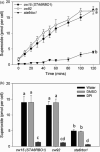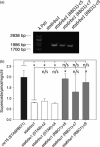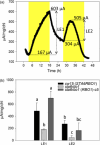Exploiting algal NADPH oxidase for biophotovoltaic energy
- PMID: 25641364
- PMCID: PMC5016757
- DOI: 10.1111/pbi.12332
Exploiting algal NADPH oxidase for biophotovoltaic energy
Abstract
Photosynthetic microbes exhibit light-dependent electron export across the cell membrane, which can generate electricity in biological photovoltaic (BPV) devices. How electrons are exported remains to be determined; the identification of mechanisms would help selection or generation of photosynthetic microbes capable of enhanced electrical output. We show that plasma membrane NADPH oxidase activity is a significant component of light-dependent generation of electricity by the unicellular green alga Chlamydomonas reinhardtii. NADPH oxidases export electrons across the plasma membrane to form superoxide anion from oxygen. The C. reinhardtii mutant lacking the NADPH oxidase encoded by RBO1 is impaired in both extracellular superoxide anion production and current generation in a BPV device. Complementation with the wild-type gene restores both capacities, demonstrating the role of the enzyme in electron export. Monitoring light-dependent extracellular superoxide production with a colorimetric assay is shown to be an effective way of screening for electrogenic potential of candidate algal strains. The results show that algal NADPH oxidases are important for superoxide anion production and open avenues for optimizing the biological component of these devices.
Keywords: Chlamydomonas; NADPH oxidase; alga; biophotovoltaic; energy.
© 2015 The Authors. Plant Biotechnology Journal published by Society for Experimental Biology and The Association of Applied Biologists and John Wiley & Sons Ltd.
Figures






Similar articles
-
Carotenoid deficiency triggers autophagy in the model green alga Chlamydomonas reinhardtii.Autophagy. 2012 Mar;8(3):376-88. doi: 10.4161/auto.18864. Epub 2012 Feb 3. Autophagy. 2012. PMID: 22302003
-
Mechanisms regulating superoxide generation in experimental models of phenylketonuria: an essential role of NADPH oxidase.Mol Genet Metab. 2011 Nov;104(3):241-8. doi: 10.1016/j.ymgme.2011.05.012. Epub 2011 May 19. Mol Genet Metab. 2011. PMID: 21640623
-
Subcellular localization and light-regulated expression of protoporphyrinogen IX oxidase and ferrochelatase in Chlamydomonas reinhardtii.Plant Physiol. 2005 Dec;139(4):1946-58. doi: 10.1104/pp.105.069732. Epub 2005 Nov 23. Plant Physiol. 2005. PMID: 16306143 Free PMC article.
-
Alternative photosynthetic electron transport pathways during anaerobiosis in the green alga Chlamydomonas reinhardtii.Biochim Biophys Acta. 2011 Aug;1807(8):919-26. doi: 10.1016/j.bbabio.2011.02.010. Epub 2011 Mar 1. Biochim Biophys Acta. 2011. PMID: 21376011 Review.
-
Intracellular generation of superoxide by the phagocyte NADPH oxidase: how, where, and what for?Free Radic Biol Med. 2010 Dec 15;49(12):1834-45. doi: 10.1016/j.freeradbiomed.2010.09.016. Epub 2010 Sep 24. Free Radic Biol Med. 2010. PMID: 20870019 Review.
Cited by
-
Life in biophotovoltaics systems.Front Plant Sci. 2023 Aug 8;14:1151131. doi: 10.3389/fpls.2023.1151131. eCollection 2023. Front Plant Sci. 2023. PMID: 37615025 Free PMC article. Review.
-
Investigation of photocurrents resulting from a living unicellular algae suspension with quinones over time.Chem Sci. 2018 Aug 31;9(43):8271-8281. doi: 10.1039/c8sc03058h. eCollection 2018 Nov 21. Chem Sci. 2018. PMID: 30542576 Free PMC article.
-
Electrical output of bryophyte microbial fuel cell systems is sufficient to power a radio or an environmental sensor.R Soc Open Sci. 2016 Oct 26;3(10):160249. doi: 10.1098/rsos.160249. eCollection 2016 Oct. R Soc Open Sci. 2016. PMID: 27853542 Free PMC article.
-
Electrochemical Characterisation of Bio-Bottle-Voltaic (BBV) Systems Operated with Algae and Built with Recycled Materials.Biology (Basel). 2018 Apr 17;7(2):26. doi: 10.3390/biology7020026. Biology (Basel). 2018. PMID: 29673222 Free PMC article.
-
Phospholipase D activation is required for 1-aminocyclopropane 1-carboxylic acid signaling during sexual reproduction in the marine red alga Neopyropia yezoensis (Rhodophyta).BMC Plant Biol. 2022 Apr 8;22(1):181. doi: 10.1186/s12870-022-03575-z. BMC Plant Biol. 2022. PMID: 35395727 Free PMC article.
References
-
- Allen, M.D. , del Campo, J.A. , Kropat, J. and Merchant, S.S. (2007) FEA1, FEA2, and FRE1, encoding two homologous secreted proteins and a candidate ferrireductase, are expressed coordinately with FOX1 and FTR1 in iron‐deficient Chlamydomonas reinhardtii . Eukaryot. Cell 6, 1841–1852. - PMC - PubMed
-
- Anderson, A. , Bothwell, J.H. , Laohavisit, A. , Smith, A.G. and Davies, J.M. (2011) NOX or not? Evidence for algal NADPH oxidases. Trends Plant Sci. 16, 579–581. - PubMed
-
- Blaby, I.K. , Glaesner, A.G. , Mettler, T. , Fitz‐Gibbon, S.T. , Gallaher, S.D. , Liu, B.S. , Boyle, N.R. , Kropat, J. , Stitt, M. , Johnson, S. , Benning, C. , Pellegrini, M. , Casero, D. and Merchant, S.S. (2013) Systems‐level analysis of nitrogen starvation‐induced modifications of carbon metabolism in a Chlamydomonas reinhardtii starchless mutant. Plant Cell, 25, 4305–4323. - PMC - PubMed
-
- Bombelli, P. , Bradley, R.W. , Scott, A.M. , Philips, A.J. , McCormick, A.J. , Cruz, S.M. , Anderson, A.A. , Yunus, K. , Bendall, D.S. , Cameron, P. , Davies, J.M. , Smith, A.G. , Howe, C.J. and Fisher, A.C. (2011) Quantitative analysis of the factors limiting solar power transduction by Synechocystis sp. PCC 6803 in biological photovoltaic devices. Energy Environ. Sci. 4, 4690–4698.
Publication types
MeSH terms
Substances
Associated data
- Actions
- Actions
- Actions
Grants and funding
LinkOut - more resources
Full Text Sources
Other Literature Sources

